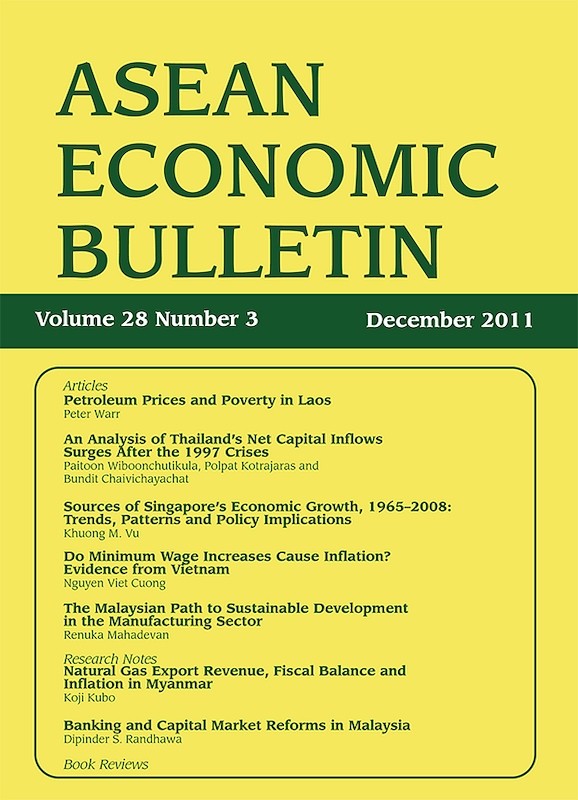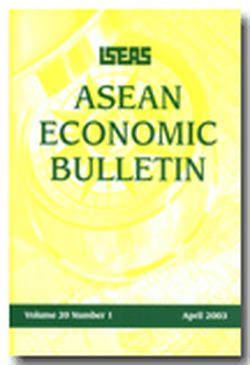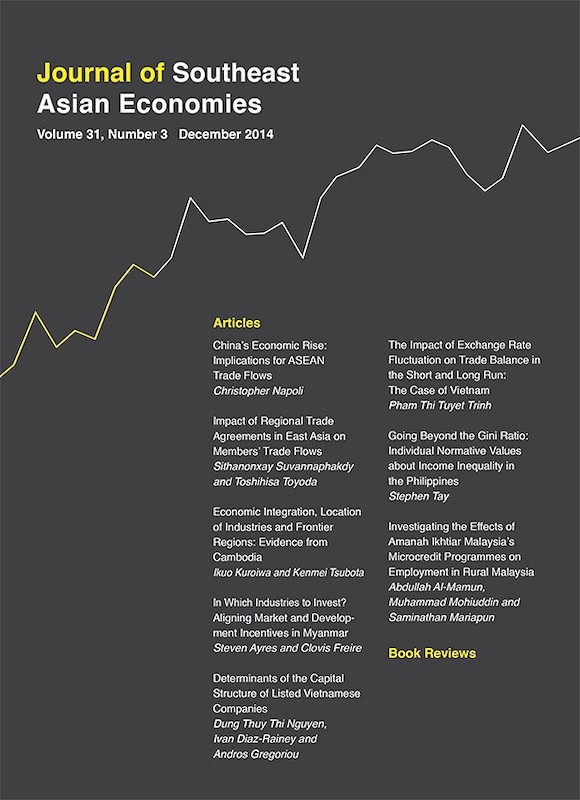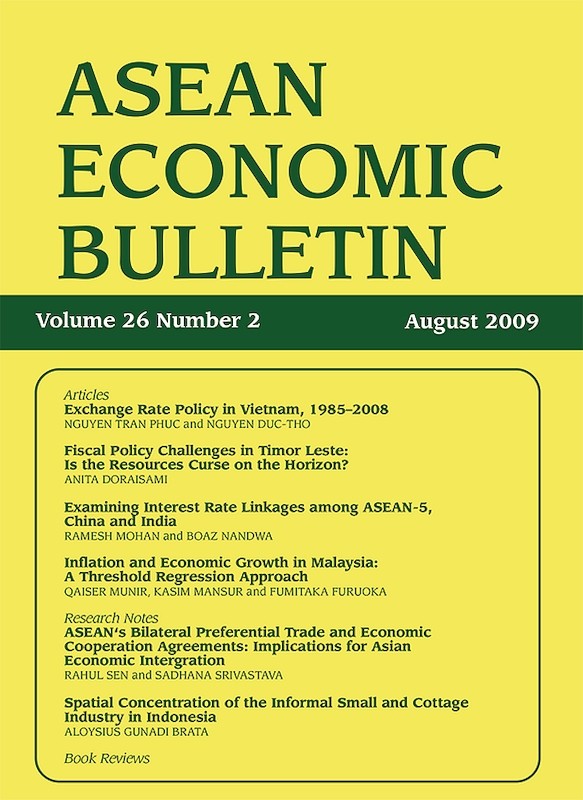ASEAN Economic Bulletin Vol. 29/1 (Apr 2012)
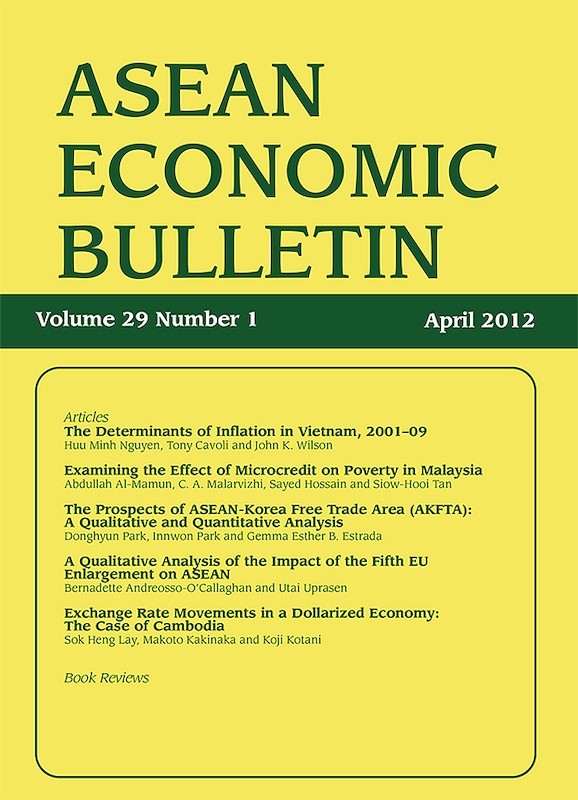
Date of publication:
April 2012
Publisher:
Institute of Southeast Asian Studies
Number of pages:
83
Code:
AE29/1
Contents
-
ASEAN Economic Bulletin Vol. 29/1 (Apr 2012)
[Whole Publication] -
Preliminary pages
- ARTICLES
-
The Determinants of Inflation in Vietnam, 200109, by Minh Nguyen, Tony Cavoli, John K Wilson, authors see abstractThis paper employs a simple macroeconomic model of inflation to empirically investigate the determinants of CPI inflation for Vietnam over the period 2001 to 2009. Vietnam is chosen as our focus for this study because of the country's recent history of high inflation since the end of the Vietnam War in 1975 and the Adjustment of Price reforms in 1985. We are particularly interested in examining the role of the exchange rate in explaining inflation, and of the effect of supply side factors such as the prices of crude oil and rice. Using a range of time series estimation techniques, we find that inflation is persistent and that the money supply, oil prices and rice prices present the strongest influences on CPI inflation.
-
Examining the Effect of Micro-credit on Poverty in Malaysia, by Abdullah al-Mamun, C A Malarvizhi, Sayed Hossain, Siow-Hooi Tan, authors see abstractThis study employs a cross-sectional design with stratified random sampling method to examine if the micro-credit programme of the Amanah Ikhtiar Malaysia (AIM) improves the income of hardcore poor households. This study uses a quasi-experimental approach and selected control and treatment group members from AIM's client's base - new and old clients respectively. It is evident that the AIM's micro-credit programme increased the household's income and reduced the poverty rate among their hardcore poor clients in Peninsular Malaysia. Findings of the study indicate the effectiveness of micro-credit in eradicating poverty. This programme should, therefore, focus on diversifying their products and services in order to increase outreach and decrease inactive borrowers and dropouts.
-
The Prospects of ASEAN-Korea Free Trade Area (AKFTA): A Qualitative and Quantitative Analysis, by Donghyun Park, Innwon Park, Gemma Esther Estrada, authors see abstractThe current global economic crisis has alerted East Asian countries to the risks of excessive dependence on exports to the United States and EU. This shared sense of vulnerability is likely to promote regional economic integration. In particular, intra-regional trade is now viewed as a new potential engine of growth. The ASEAN-Korea Free Trade Area (AKFTA) is a concrete example of this general trend. This paper qualitatively and quantitatively examines the economic feasibility and desirability of AKFTA - qualitatively using the theory of economic integration and quantitatively by applying a CGE model. Our analysis provides some grounds for optimism about AKFTAs prospects.
-
A Qualitative Analysis of the Impact of the Fifth EU Enlargement on ASEAN, by Utai Uprasen, author see abstractThis paper scrutinizes the impact of the fifth EU enlargement on the changes of ASEAN's patterns of trade by focusing on ASEAN-7's exports at the sectoral level using a qualitative framework. This approach differs from other conventional studies that look at the impact of the enlargement on either the EU or the new EU member countries. Two new trade indices are proposed in this paper, namely the Rivalry Threat Index (RTI) and the Export Threat Index (ETI). The analysis is conducted at the 3-digit level of SITC Rev.3 industry for the years 1997, 2000, 2003 and 2006. The findings indicate that: the degree of threat on ASEAN exports (emanating from the new accession countries) to the EU15 market are not significantly high in general; the effects on the major exporting products from ASEAN to the EU15 (SITC7 and 8 categories) are fairly high; ASEAN countries may face a very intense degree of export threat in the services sectors. Nonetheless, the major trade partners of ASEAN (i.e. the USA, Japan and China) may be able to help ASEAN neutralise the export threat on the EU15 market by acting as a shock absorber for ASEAN exports.
-
Exchange Rate Movements in a Dollarized Economy: The Case of Cambodia, by Sok Heng Lay, Makoto Kakinaka, Koji Kotani, authors see abstractThere has been an ongoing debate on whether dollarization helps stabilize exchange rates for emerging economies. This paper discusses this issue in a highly dollarized country, Cambodia, by empirically examining the relationship between dollarization and exchange rate movements. The GARCH analysis suggests that dollarization induces the depreciation of the Cambodian riel as well as intensifies exchange rate variability. The result is consistent with the argument that dollarization is one of the crucial causes of exchange rate instability. Dollarization in Cambodia could be a constraint on poverty reduction since it tends to affect the living standard of the poor who earn the income in the riel through the depreciation of the currency and intensified volatility of exchange rates.
- BOOK REVIEWS
-
BOOK REVIEW: Malaysia: Policies and Issues in Economic Development, by ISIS, Malaysia., by G Sivalingam, author
-
BOOK REVIEW: Economic Crises and the Breakdown of Authoritarian Regimes: Indonesia and Malaysia in Comparative Perspective, by Thomas B. Pepinsky., by Francis E Hutchinson, author

